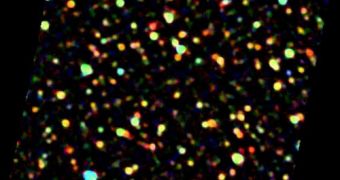It would appear that officials at the European Space Agency (ESA) were not boasting for nothing when they said that the Herschel Space Observatory is the most advanced and sensitive infrared space-based telescope in existence today. The machine never disappoints when astronomers want it to peer as deep into the early Universe as its eyes would carry it, and this is visible in the over 1,100 previously-unseen galaxies that Herschel discovered. Adding to these extraordinary feats, the telescope recently managed to peer through an inconveniently-placed cosmic veil, and find a swarm of distant galaxies behind it, Space reports.
These particular galaxies are very important because they represent the farthest ones Herschel ever discovered. According to initial estimates, it would appear that they are about 16 percent the age of the Universe, which would make them relatively recent. The three sensitive instruments on the telescope allowed for researchers to determine that all of these cosmic structures are producing stars at an incredibly high rate, which means that they have active stellar nurseries (or nebulae) within. This could be one of the main reasons why they became visible to the infrared detectors on the observatory, experts say.
“We can use these results to study what controls star formation in these distant galaxies, and how galaxies like our Milky Way formed,” explains Max Planck Institute for Extraterrestrial Physics expert Dieter Lutz, who is also the leader of the new investigation. He adds that Herschel is the only telescope today that is advanced enough to look at the cosmic infrared background (CIB), and see distant, separate structures within. This background is produced by IR light radiating from numerous sources, including cosmic dust. It appeared shortly after the Big Bang, and it permeates the Universe altogether.
When observed with less-sensitive infrared optics, it appears as a slight blur on the images, but it becomes readily visible with more advanced observational capabilities. When seen with Herschel, the CIB reveals its most distant “contributors,” that otherwise remain obscured in the background for good. The newly-found structures add to the 1,100+ that were already discovered, all due to Herschel's participation in the Great Observatories Origins Deep Survey (GOODS) initiative. The project centralizes data from European and American telescopes, in order to create comprehensive maps of the Universe.

 14 DAY TRIAL //
14 DAY TRIAL //